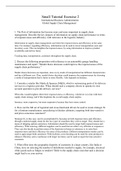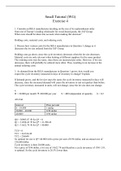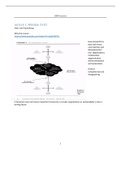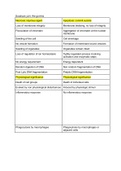School of Science and Engineering
MSc Cyber Security Engineering
Academic Year 2023-2024
Gemma Mill
Personal Learning Record
Assignment 1
Computer Fundamentals - COM709
Tutor: Dr Kalin Penev 13/12/2023
0
,Contents
Table of Figures.................................................................................................................................. 2
Introduction......................................................................................................................................... 2
Computer Structure Functioning and Architecture.............................................................3
Functions.......................................................................................................................................... 3
Structure........................................................................................................................................... 4
Number Systems................................................................................................................................ 5
Decimal System.............................................................................................................................. 5
Binary System................................................................................................................................. 5
Hexadecimal System.................................................................................................................... 6
Floating Point................................................................................................................................. 6
Single-Precision Floating Point.......................................................................................... 7
Double-Precision Floating Point........................................................................................ 7
Long double floating point................................................................................................... 7
Computer Processors, Performance, Energy Efficiency and Cooling...........................9
Computer Processor.................................................................................................................... 9
Performance.................................................................................................................................... 9
Energy Efficiency and Cooling................................................................................................. 9
Storage Principles, types, and evaluation.............................................................................. 11
SSD and HDD................................................................................................................................ 11
ROM and RAM.............................................................................................................................. 11
NAS – Models, applications, and Evaluation........................................................................12
NAS Comparison......................................................................................................................... 12
RAID................................................................................................................................................. 12
Advanced Concepts and Algorithms........................................................................................ 14
Sorting Algorithms..................................................................................................................... 14
Advanced Algorithms............................................................................................................... 14
Conclusion.......................................................................................................................................... 16
References.......................................................................................................................................... 17
Appendices plus artefacts............................................................................................................ 19
Artefact 1: Program for floating point in float, double and long double format.
............................................................................................................................................................ 19
Artefact 2: Sorting Algorithm of my choice......................................................................20
1
, Table of Figures
Figure 1: Functional View of the computer............................................................................. 3
Figure 2: Binary number system table...................................................................................... 5
Figure 3: Representation of the number systems................................................................6
Figure 4: Single-Precision Floating Point................................................................................. 7
Figure 5: Double-Precision Floating Point..............................................................................7
Figure 6: Long-Double Floating Point....................................................................................... 8
Figure 7: Comparison of 2 processors.................................................................................... 10
Figure 8: Comparison between SSD and HDD.....................................................................11
Figure 9: Types of NAS.................................................................................................................. 12
Figure 10: Different Raid types................................................................................................. 13
Introduction
This personal learning record is going to include all the information and tasks
that have been completed through the first semester of the computer
fundamentals course.
The course has included the following information that is going to be covered
using convincing evidence within this document.
1. Computer Structure functioning and architecture
2. Number systems
3. Computer processors, performance, energy efficiency and cooling
4. Storage principles, types, and evaluation
5. NAS – Models, applications and Evaluation
6. Advanced concepts and algorithms
All the tasks that have been listed above have been completed and evidence has
been compelled along with the key skills that have been developed through this
learning process.
2










